Just outside the city limits lies a completely overlooked hidden gem in Paris — the fantastic Basilica Cathedral of Saint-Denis. In this Saint-Denis guide, you’ll discover everything to see at this overlooked religious gem.
Saint-Denis is a French national treasure. The church is the birthplace of Gothic architecture.
It heralded Europe’s transition from a clunky Romanesque style to a more elegant Gothic one. The church influenced all European ecclesiastical structures throughout the Middle Ages.
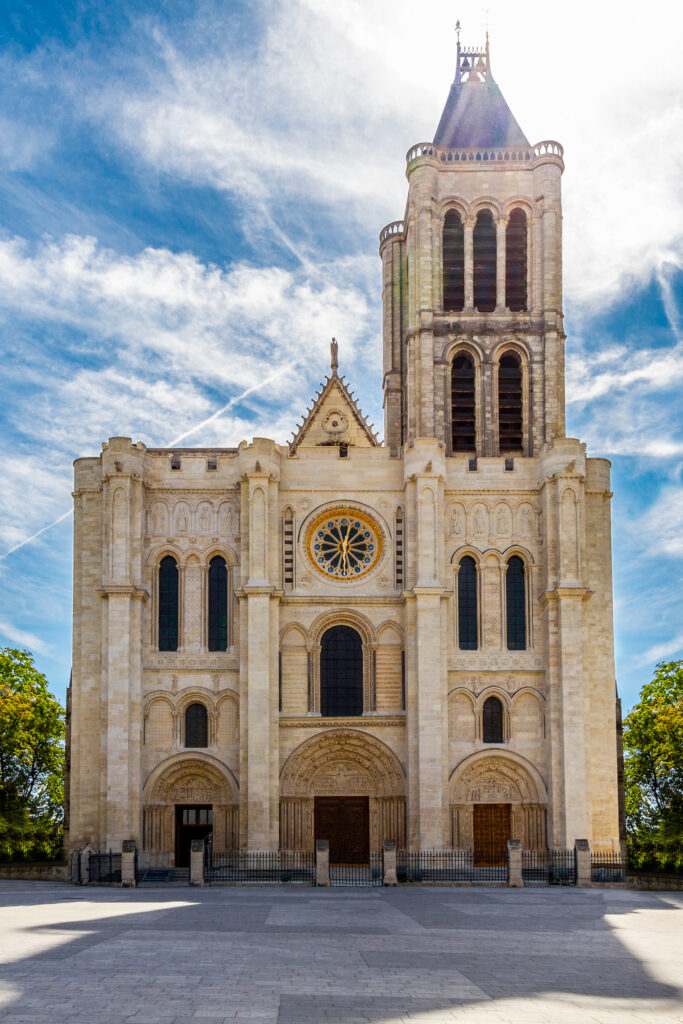
As the world’s first Gothic church, the basilica is even on the tentative UNESCO list. If it still had its north tower, it might be already.
Saint-Denis is a repository of French history. Its namesake is a 3rd century decapitated saint. Since 1122, Saint-Denis has been the official burial site of French royalty.
As a result, it’s essentially a museum of monumental French religious sculpture, showcasing the death styles of the rich and famous.
Saint-Denis should definitely be on everyone’s must see list for Paris, even if it requires a metro ride.
Since it’s not (at least yet), the basilica is ideal spot for a quiet contemplative visit — a rare thing in sometimes overcrowded Paris. If you don’t visit it on your first visit to Paris, schedule Saint-Denis for your second.
Off With His Head! The Legend of Saint Denis
The Basilica of Saint-Denis is named after France’s most famous “Cephalophoric” saint, Saint Denis, the first Bishop of Paris.
Cephalophore is a term the Catholic church invented for saints who carry their decapitated heads, signifying they’re divine and have died a martyr’s death. There were apparently so many of these saints, a new word was required.
These saints were amazing. They could walk and talk while carrying their own heads.
Legend holds that, around 250 A.D., during an anti-Christian epoch, the Romans beheaded Saint Denis in Montmartre for having the gaul to try to evangelize Gaul. There’s a commemorative decapitated statue at Square Suzanne Buisson in Montmartre.
The corpse-like Saint Denis then carried his head down the Rue de Martyrs and over 4 miles to the current location of Saint-Denis.
Losing his head wasn’t enough to silence him. Saint Denis delivered a sermon, before finally collapsing.
You can see the famous Cephalophore on the facade of Notre Dame de Paris, to the left of the main door. His statue survived the fire.
He also makes on appearance on the facade of Reims Cathedral. His death is a colorful tale and a popular subject for artists.
History of the Basilica Cathedral of Saint-Denis
In the 7th century, the basilica’s chief benefactor, the Merovingian King Dagobert, transformed the pilgrimage shrine into the Benedictine Abbey of Saint-Denis.
Dagobert interred the martyr’s relics there. Not long after, he was the first French king to be buried there, kicking off the tradition. Saint Denis’ resting place became a pilgrimage site.
In the 12th century, the abbey was expanded by Abbot Suger. He was a French holy man, statesman, and advisor to the king. Indeed, he was regent to Louis VII when he was in his minority.
Abbot Suger was innovative. To accommodate the expansion, he introduced technologically advanced Gothic elements — pointed arches, flying buttresses, stained glass windows, and ribbed vaults.
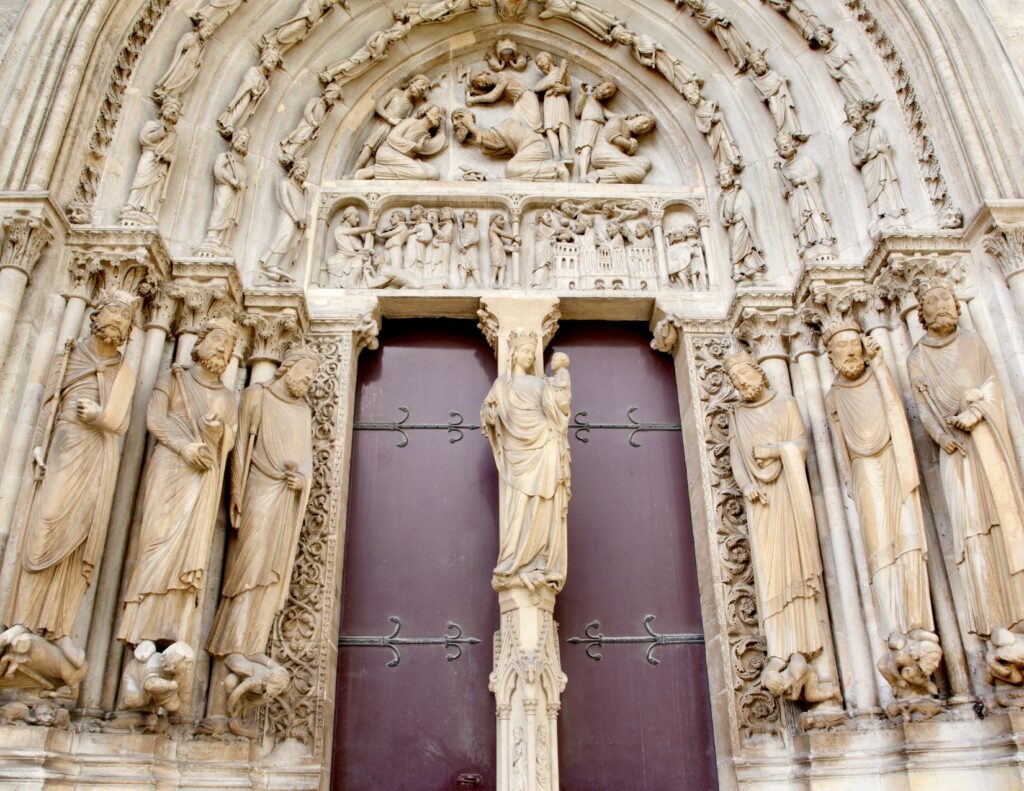
The more refined style focused on lightness and lacy facades. This was a stark contrast to the then-prevailing rather clunky Romanesque style, where the stone simply held the building up.
Through the sheer spiritual force of his new building, Abbot Suger hoped to elevate the abbey and inspire the Benedictine monks, whose order needed some major cleaning up. Falling into complacency and gorging on saturated fats, the monks had become fat, worldly, and depraved.
Peter Abelard, the religious philosopher Abelard and Heloise fame, accused the monks of “intolerably foul practices, both in private and in public.”
It’s unclear whether Abelard was behaving much better … he seduced his student. Abelard and Heloise’s grave is in Pere Lachaise Cemetery in Paris.
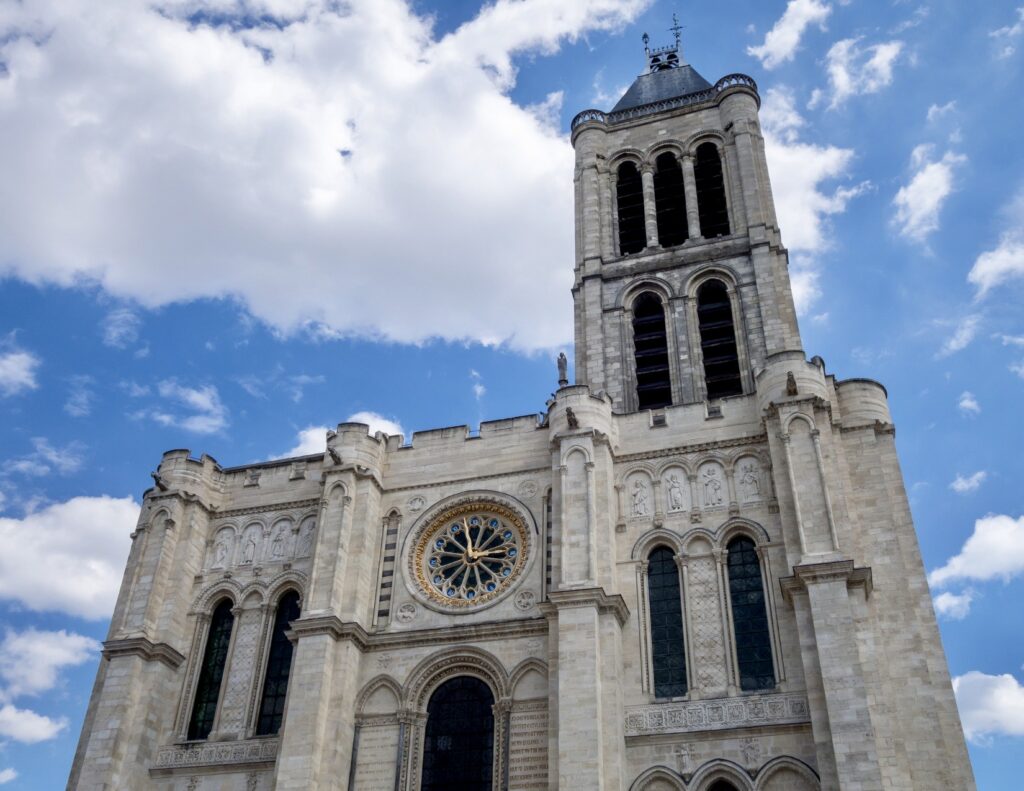
The basilica was used for the coronation of French queens, though the French Kings were crowned at Reims Cathedral.
In 1966, the Basilica Saint-Denis was renamed a cathedral, so it now carries both descriptors. It’s also on UNESCO’s “tentative” list for World Heritage Site designation.
Guide To Saint-Denis: What To See
1. Exterior Facade
Saint-Denis is considered the birthplace of Gothic architecture and a model for other French cathedrals.
Its exterior is stark and famously lopsided. Perhaps that’s what dissuades some tourists from visiting.
With its arched portals, the facade isn’t truly Gothic. It echoes St. Étienne in Caen, the burial place of the Dukes of Normandy. Bishop Suger gifted the bronze doors.
The more ornate North Tower was struck by lightning in 1837 and suffered from a storm in 1840. In 1847, Viollet-le-Duc dismantled it.
Though it was considered the most spectacular spire in Paris in the 13th century, it was never rebuilt.
But in March 2013, the mayor of the town of Saint-Denis announced the future reconstruction of the tower.
Construction is set to begin in May 2020 and hopefully be complete by 2031. Such a major reconstruction is extremely exciting, even if controversially expensive.
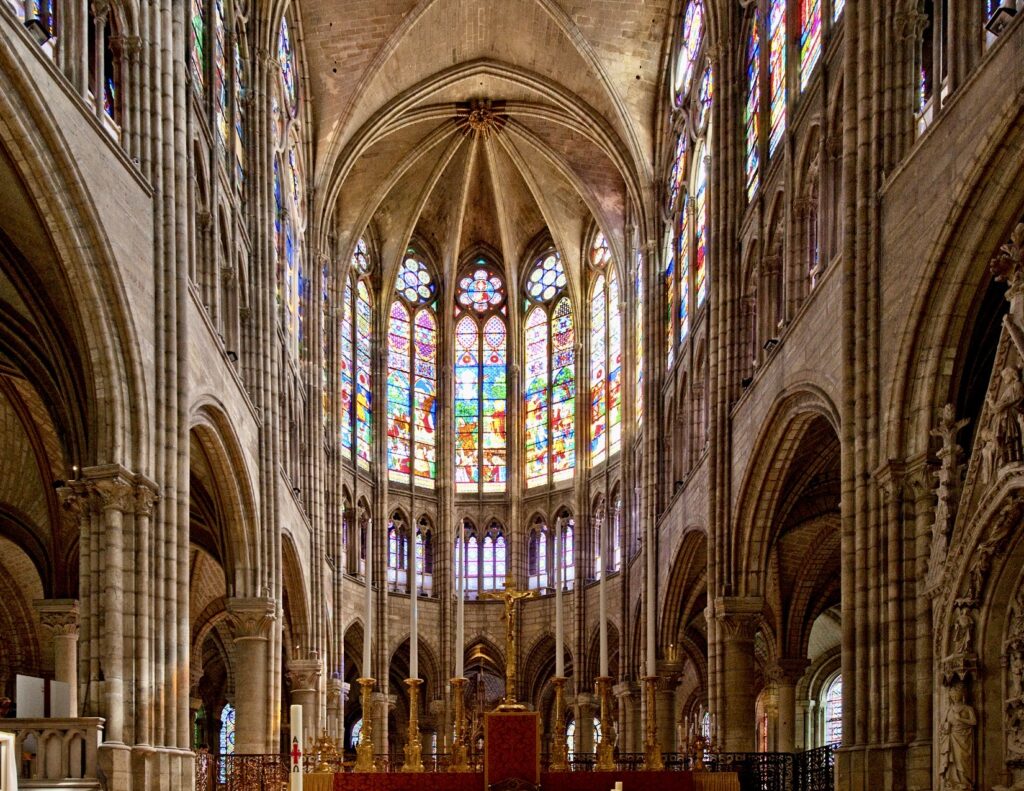
2. The Basilica Interior
The new Rayonnant style reduced the width and breath of the previously thick and bulky walls. The new apse had a forest of monolithic columns.
The columns supported one of the first successful ribbed vaults. In the nave, vast stained glass windows replaced solid masonry. It was revolutionary.
The stained glass windows apparently cost more than the stone building itself. They were famous for the blue color of the glass called “the blue of Saint-Denis.”
Not much remains of the original 12th century glass, much of it destroyed during the French Revolution. The glass in the upper part of the building was commissioned by Gothic Revival architect Viollet-le-Duc in the 19th century.
The nave is 188 meters long and 30 meters high. As Abbot Suger intended, the 13th century choir is suffused with light and beautiful clerestory windows.
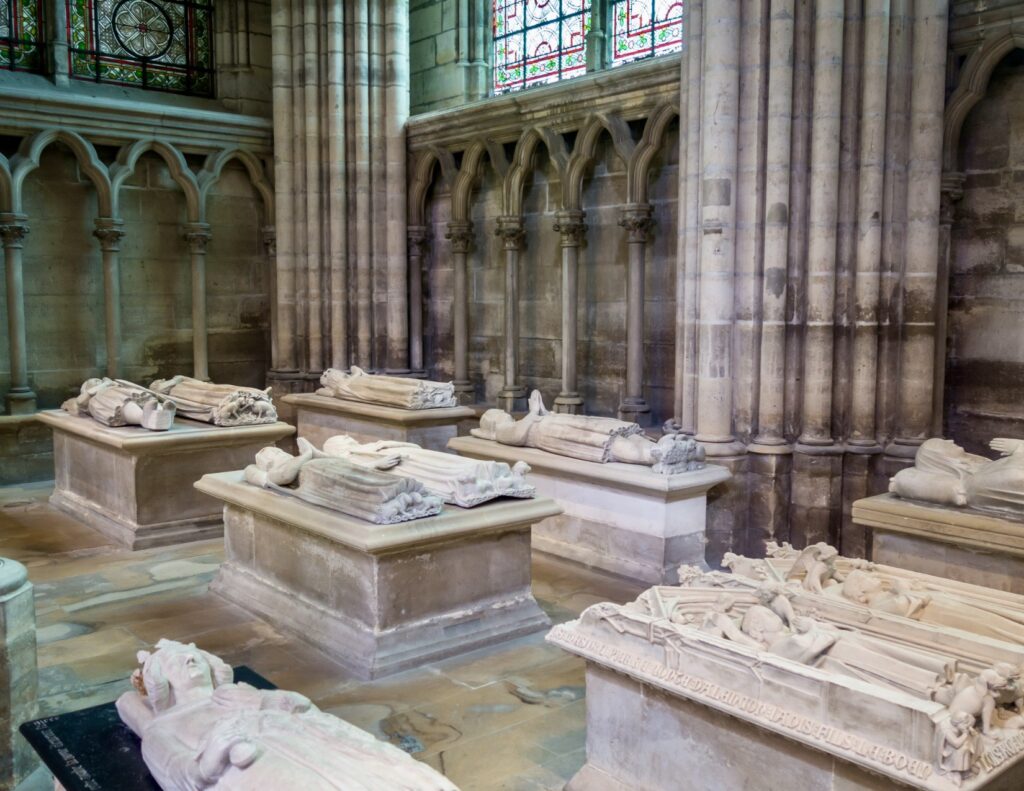
3. Royal Necropolis of Saint-Denis Basilica
The most fascinating part of the basilica, which completely makes it worth the short Metro ride, is the royal necropolis. And it’s not just a necropolis. It’s Paris’ royal hall of fame, representing the history of the French monarchy.
These effigies are high art, similar to those in Pere Lachaise Cemetery. The opulent tombs were a symbol of royal power in those days.
During the French Revolution, the basilica was ransacked. The ornate tombs were seen as untoward symbols of the Ancien Régime.
Tombs were destroyed and grave robbers swooped up any jewels or valuables inside. The royal remains were mixed with lime and thrown into two mass graves in the abbey cemetery.
Despite all that, Saint-Denis still houses over 70 royal tombs. Many of the tombs and sculptures were hidden during the bloody events.
Archaeologist Alexandre Lenoir stashed some of them in the Museum of French Monuments. Eventually, Napoleon reopened the basilica in 1806.
All but 3 of France’s kings are buried here, along with other nobility. Here’s a map of the tombs. There’s definitely some serious monarchial musk in the air at Saint-Denis.
The most important tombs are those of Dagobert I, Clovis I, Catherine de Medici, Francois I, Louis XV, Louis XVI, and Marie Antoinette.
Louis XVIII was the last king to be buried here, in 1824. Even Louis XIV’s body is buried there. But not all of it.
As was the custom then, the king’s entrails were transported to Notre Dame Cathedral and his heart placed in the church of Saint-Louis des Jésuites.
They even had “heart tombs” back then. The king’s heart was a symbol of political power, so the kings spread their hearts around France.
The royal tombs are mainly in the nave. The monarchs are represented in carved recumbent effigies or on raised bases.
Many of their faces are supposedly realistic, modeled on death masks.
Some were severely damaged or intentionally vandalized during the French Revolution. They were subsequently restored by architect Viollet-le-Duc in 1860.
Tombs of the non-royal saints are in the side chapels.
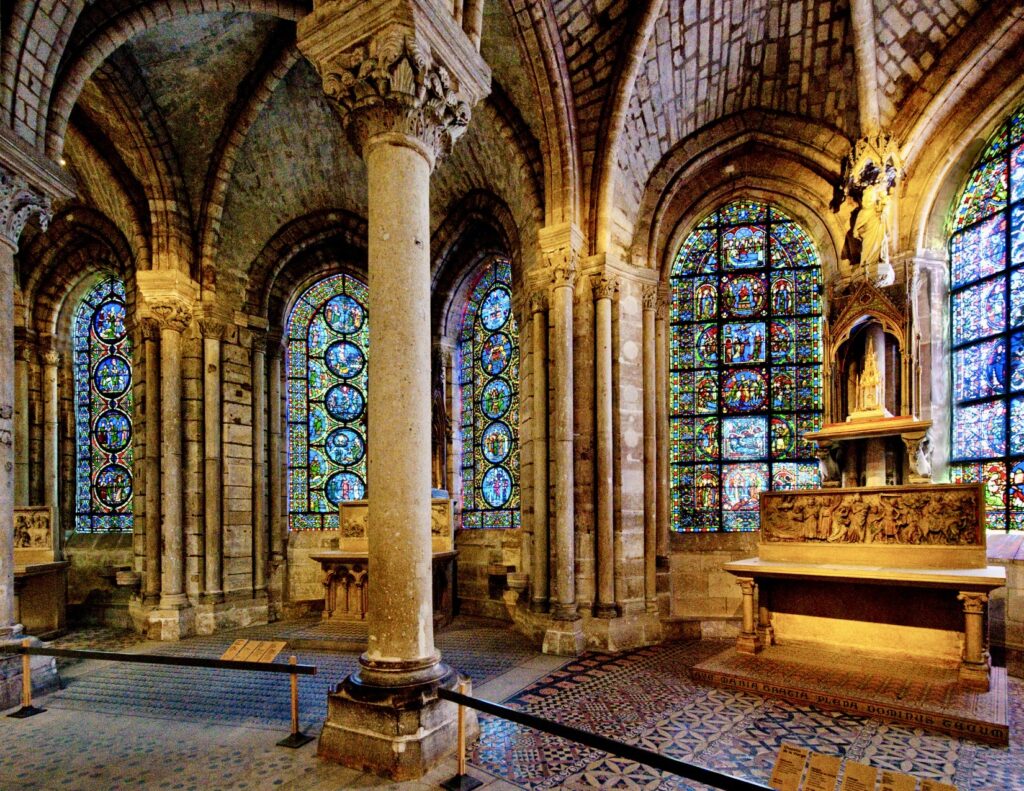
4. Saint-Denis Crypt
You can also venture into the dimly lit Romanesque crypt. Parts of the crypt survive from the 8th century.
You’ll find the tombs of St. Denis (possibly), the Royal Ossuary, Suger’s tomb, and the Bourbon Chapel.
The Bourbon Chapel is open to the public. It holds some effigies and the remains of the kings and queens unceremoniously thrown into the open cemetery.
With few exceptions, the bodies couldn’t be identified so were put in an ossuary. It’s marked by a black plate in the crypt.
Viollet-le-Duc made the first excavations of the crypt in the mid-nineteenth century. Nearly a century later, excavations were resumed. Between 1953-1973, archaeologists made further studies.
Beneath the high altar, a vast pit was uncovered. It was assumed to be grave of Saint Denis. However, there was no body in it. The derivation of the pit is still a subject of controversy.
Put the Basilica of Saint-Denis on your to do list for Paris. It’s a vivid example of the early stages of the Gothic movement, a space that truly embodies a balance between life and death.
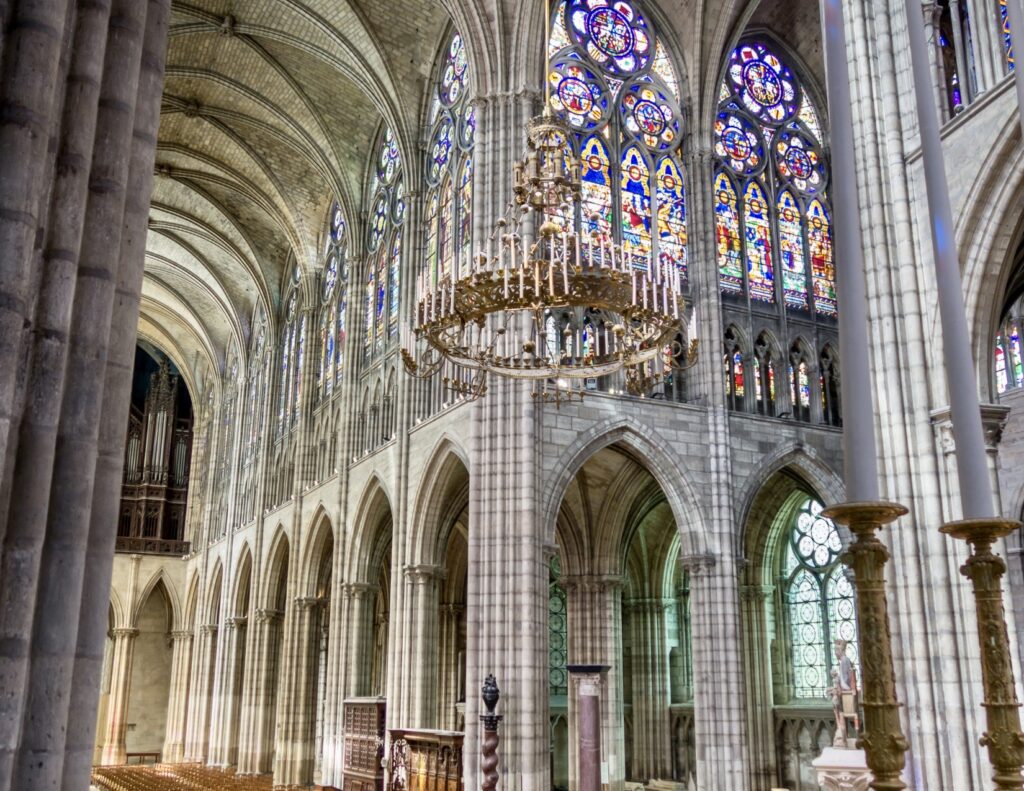
Practical Guide for Visiting the Basilica de Saint-Denis:
Address: 1 rue de la Legion D Honneur, 93200 Saint-Denis, France
Hours: Open Apr 1 to Sept 30: Mon to Sat from 10:00 am to 6:15 pm & Sun from noon to 6:15 pm. From Oct 1 to Mar 31: Mon to Sat from 10:00 am to 5:15 pm & Sunday noon to 5:15 pm
Entry fee: Entry to the main nave is free. Access to the tombs and crypt is adults 9.50 €, under 18 free, audioguide, 4.50 €
Metro: Gare Saint-Lazare and the Champs-Élysées
Pro tip: It’s cold inside, even in the summer.
I hope you’ve enjoyed my guide to the Basilica Cathedral of Saint-Denis. You may enjoy these other Paris travel guides and resources:
- 5 Day Itinerary for Paris
- 3 Day Itinerary for Paris
- 2 Day Itinerary for Paris
- Tips for Planning a Trip to Paris
- Tourist Traps To Avoid In Paris
- Top Attractions in Montmartre
- Top Attractions in the Marais
- Best Museums In Paris
- Hidden Gems in Paris
- Best Churches in Paris
- Best Things To Do in Paris in Winter
- Guide to the Opera District
- Secret day trips from Paris
If need a guide to Saint-Denis, pin it for later.

